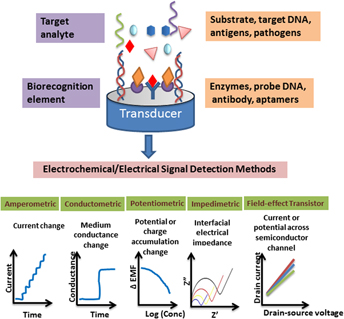Crossref Citations
This article has been cited by the following publications. This list is generated based on data provided by
Crossref.
Basu, J.
Baral, A.
Samanta, N.
Mukherjee, N.
and
Roychaudhuri, C.
2018.
Low Noise Field Effect Biosensor with Electrochemically Reduced Graphene Oxide.
Journal of The Electrochemical Society,
Vol. 165,
Issue. 8,
p.
B3201.
Camerlingo, Carlo
Verde, Alessandro
Manti, Lorenzo
Meschini, Roberta
Delfino, Ines
and
Lepore, Maria
2018.
Graphene-Based Raman Spectroscopy for pH Sensing of X-rays Exposed and Unexposed Culture Media and Cells.
Sensors,
Vol. 18,
Issue. 7,
p.
2242.
Zhen, Xue V.
Swanson, Emily G.
Nelson, Justin T.
Zhang, Yao
Su, Qun
Koester, Steven J.
and
Bühlmann, Philippe
2018.
Noncovalent Monolayer Modification of Graphene Using Pyrene and Cyclodextrin Receptors for Chemical Sensing.
ACS Applied Nano Materials,
Vol. 1,
Issue. 6,
p.
2718.
Vishnu, Nandimalla
Sahatiya, Parikshit
Kong, Chang Yi
and
Badhulika, Sushmee
2019.
Large area, one step synthesis of NiSe2 films on cellulose paper for glucose monitoring in bio-mimicking samples for clinical diagnostics.
Nanotechnology,
Vol. 30,
Issue. 35,
p.
355502.
Tite, Teddy
Chiticaru, Elena Alina
Burns, Jorge S.
and
Ioniţă, Mariana
2019.
Impact of nano-morphology, lattice defects and conductivity on the performance of graphene based electrochemical biosensors.
Journal of Nanobiotechnology,
Vol. 17,
Issue. 1,
Chepyala, Ramchander
Badruddoza, Abu Zayed Md
Azad, Mohammad
McCarthy, Jason R.
and
Nurunnabi, Md
2019.
Biomedical Applications of Graphene and 2D Nanomaterials.
p.
187.
Ahammad, A.J. Saleh
Islam, Tamanna
and
Hasan, Md. Mahedi
2019.
Biomedical Applications of Graphene and 2D Nanomaterials.
p.
249.
Yang, Xi
Liu, Xin
and
Song, Jun
2019.
A Study on Technology Competition of Graphene Biomedical Technology Based on Patent Analysis.
Applied Sciences,
Vol. 9,
Issue. 13,
p.
2613.
Kanyong, Prosper
Patil, Amol V.
and
Davis, Jason J.
2020.
Functional Molecular Interfaces for Impedance-Based Diagnostics.
Annual Review of Analytical Chemistry,
Vol. 13,
Issue. 1,
p.
183.
PA, Sreekumar
Afzal, Hafiz Muhammad
and
Al‐Harthi, Mamdouh A.
2020.
Hybrid Ni‐Al layered double hydroxide/graphene reinforced polyvinyl alcohol/starch blends.
Polymer Composites,
Vol. 41,
Issue. 10,
p.
4253.
Al-abodi, Hiba Riyadh
Jawad, Zainab Nizar
Al-Yasiri, Mohammed Hashim
Al-Saadi, Aamal Ghazi Mahdi
Memariani, Hamed
Sabokrouh, Abdolreza
and
Mohammadi, Reza
2020.
Novel gold nanobiosensor platforms for rapid and inexpensive detection of Vibrio cholerae.
Reviews in Medical Microbiology,
Vol. 31,
Issue. 2,
p.
70.
Adhikari, Juthi
Rizwan, Mohammad
Keasberry, Natasha Ann
and
Ahmed, Minhaz Uddin
2020.
Current progresses and trends in carbon nanomaterials‐based electrochemical and electrochemiluminescence biosensors.
Journal of the Chinese Chemical Society,
Vol. 67,
Issue. 6,
p.
937.
Al-Dhahebi, Adel Mohammed
Gopinath, Subash Chandra Bose
and
Saheed, Mohamed Shuaib Mohamed
2020.
Graphene impregnated electrospun nanofiber sensing materials: a comprehensive overview on bridging laboratory set-up to industry.
Nano Convergence,
Vol. 7,
Issue. 1,
Tian, Siyu
Wu, Shiwen
and
Xiong, Guoping
2020.
Graphitic nanopetals and their applications in electrochemical energy storage and biosensing.
Journal of Nanoparticle Research,
Vol. 22,
Issue. 5,
Chen, Mengxi
Christmann, Augusto M.
Muniz, Andre R.
Ramasubramaniam, Ashwin
and
Maroudas, Dimitrios
2020.
Molecular-Dynamics Analysis of Nanoindentation of Graphene Nanomeshes: Implications for 2D Mechanical Metamaterials.
ACS Applied Nano Materials,
Vol. 3,
Issue. 4,
p.
3613.
Singh, Aparajita
and
Kumar, Vinod
2020.
Internet of Things and Big Data Applications.
Vol. 180,
Issue. ,
p.
243.
Lu, Xiaohui
Cui, Mingxuan
Yi, Qicheng
and
kamrani, Amin
2020.
Detection of mutant genes with different types of biosensor methods.
TrAC Trends in Analytical Chemistry,
Vol. 126,
Issue. ,
p.
115860.
Basak, Soumyadeep
and
Packirisamy, Gopinath
2021.
Graphene‐Based Nanomaterials for Biomedical, Catalytic, and Energy Applications.
ChemistrySelect,
Vol. 6,
Issue. 36,
p.
9669.
Afroj, Shaila
Britnell, Liam
Hasan, Tahmid
Andreeva, Daria V.
Novoselov, Kostya S.
and
Karim, Nazmul
2021.
Graphene‐Based Technologies for Tackling COVID‐19 and Future Pandemics.
Advanced Functional Materials,
Vol. 31,
Issue. 52,
Pilan, Luisa
and
Raicopol, Matei
2021.
Carbon Related Materials.
p.
209.




